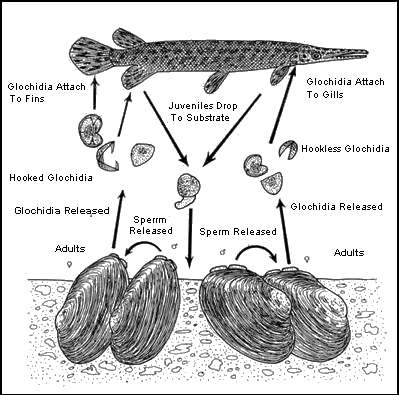

Freshwater mussels, the vacuum cleaners of the aquatic ecosystem, feed by filtering algae and small particles from the water. Larvae are released by the female mussel and must locate a certain fish species or die. They usually attach to the host fish’s gills or fins where they remain for a few weeks or months. Larval mussels rarely harm infected fish under natural conditions. When they become juveniles, they drop back to the substrate for the cycle to begin again. If essential fish species are removed from the habitat, mussels will not be able to reproduce.
Adult mussels can range from less than one inch in length to nearly 12 inches long. Some species have thin shells and a life-span of only 5 or 6 years, while others have thick shells and can live well over 50 years. Shells vary both on the inside and outside of mussels, depending upon the mussel species. Color, texture, and shape variations in shells are used to help identify different types of mussels.
Freshwater mussels have been collected by commercial musselers for the cultured pearl industry. A cultured pearl is formed by taking a round core from the shell of some of our larger […]
Full article: Texas Mussel Watch: Texas Freshwater Mussel Biology
Fracking wastewater accumulation found in freshwater mussels’ shells
Microplastics in our mussels: the sea is feeding human garbage back to us
Washington state to use dog to detect invasive mussels on boats
EPA researching freshwater mussels as biofilters in PA, MD and WV
Clean water is essential for life, yet millions of Americans unknowingly consume contaminants through their…
Human brains contain higher concentrations of microplastics than other organs, according to a new study, and the…
From the Office of the Governor: In anticipation of a multi-day, significant atmospheric river in Northern California,…
From Governor Newsom: Scientists, water managers, state leaders, and experts throughout the state are calling…
Photo: A harmful algal bloom in Milford Lake, Kansas, made the water appear bright green.…
An expanded plastic foam coffee cup is at a donut shop in Monterey Park, California.…